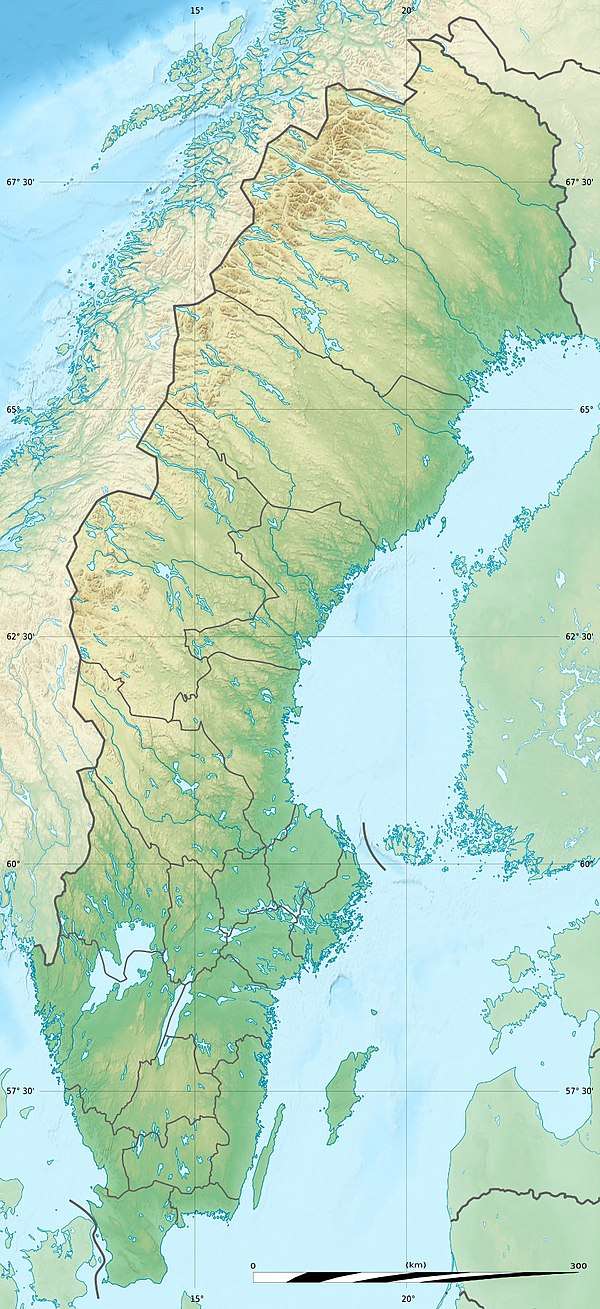High Coast
The High Coast (Swedish: Höga Kusten) is a part of the coast of Sweden on the Gulf of Bothnia, in the Ångermanland province of northeast Sweden, centered in the area of the municipalities of Kramfors, Härnösand, and Örnsköldsvik. It is notable as an area for research on post-glacial rebound and eustacy, in which the land rises as the covering glaciers melt, a phenomenon first recognised and studied there. Since the last ice age, the land has risen 300 meters, which accounts for the region's unusually tall cliffs. The High Coast is part of the Swedish/Finnish High Coast/Kvarken Archipelago World Heritage Site.
| UNESCO World Heritage Site | |
|---|---|
 View over the High Coast from the top of the Skule Mountain in August 2013 | |
| Location | Västernorrland County, Sweden |
| Part of | High Coast / Kvarken Archipelago |
| Criteria | Natural: (viii) |
| Reference | 898bis-001 |
| Inscription | 2000 (24th session) |
| Extensions | 2006 |
| Area | 142,500 ha (352,000 acres) |
| Coordinates | 63°0′N 18°30′E |
 Location of High Coast in Sweden | |
History
The area known today as Höga Kusten has historically been known as the Ångermanland Coast.[1][2]
In 1974, the term High Coast (Swedish: Höga Kusten) was coined in connection with a report on the area.[3]
In 2000, UNESCO put the area on the World Heritage List:
"The High Coast site affords outstanding opportunities for the understanding of the important processes that formed the glaciated and land uplift areas of the Earth's surface."
In 2006, the High Coast was joined with the Finnish Kvarken areas.
Geography
The relief of the High Coast is that of a large scale joint valley terrain that dissects uplifted remnants of the Sub-Cambrian peneplain.[4][5]
Attractions
The most popular places to visit in the High Coast of Sweden are Skule Mountain, Skuleskogen National Park, and the islands Ulvön and Trysunda.
The High Coast of Sweden is considered to be excellent for hiking and has been cited as one of the best hiking regions in Sweden.
Both outdoor magazines (such as Utemagasinet and Outside) and daily newspapers (such as Svenska Dagbladet) rank the High Coast Trail as one of the best of Sweden's hiking trails.
The Höga Kustenleden is a 128-kilometer long trail along the High Coast. For day hikes, Skule Mountain and Skule National park are popular. The High Coast Hike (Höga Kusten Hike) is an annual event considered suitable for both experienced and new hikers.
References
- Johan Nordlander 1853-1934 Gävlebornas fiskefärder till Ångermanlands kust 1924 (Trips to the Ångermanland coast by fishermen from Gävle)
- Lars Silén. Några ryggradslösa havsdjur från Ångermanlands kust (utanför Ulvön); Svensk faunistisk revy; 1955(17):4, s. 110-114Marine invertebrates from the Ångermanland coast (outside Ulvön). Included in the Swedish Revue of Fauna 1955 (17):4 pp 110-114
- Höga Kustenutredningen. Huvudrapport Höga Kusten-kommittén. Härnösand: Kommittén, 1974 (Swedish) 329 s., 5 maps (Main report from the High Coast Committee. Härnösand 1974.
- Lidmar-Bergströrm, Karna (1995). "Relief and saprolites through time on the Baltic Shield". Geomorphology. Elsevier. 12: 45–61.
- Lidmar-Bergström, Karna; Olvmo, Mats (2015). Plains, steps, hilly relief and valleys in northern Sweden – review, interpretations and implications for conclusions on Phanerozoic tectonics (PDF) (Report). Geological Survey of Sweden. p. 12. Retrieved 2016-06-29.
Bibliography
- Bergström, Lars (1975). Höga kusten: natur, människor och tradition längs kusten från Sundsvall till Örnsköldsvik - ett av Sveriges vackraste och mest särpräglade landskap ISBN 91-0-040427-6 Stockholm : Bonniers 1975 80pp (The High Coast: the landscape, people and traditions along the coast from Sundsvall to Örnsköldsvik - one of Sweden's most beautiful and distinctive landscapes) (Swedish)
External links
![]()